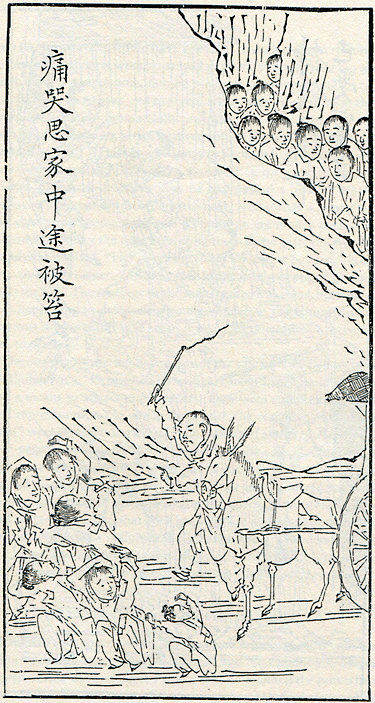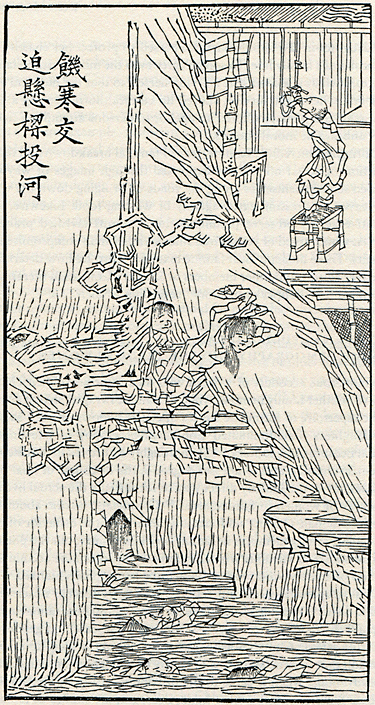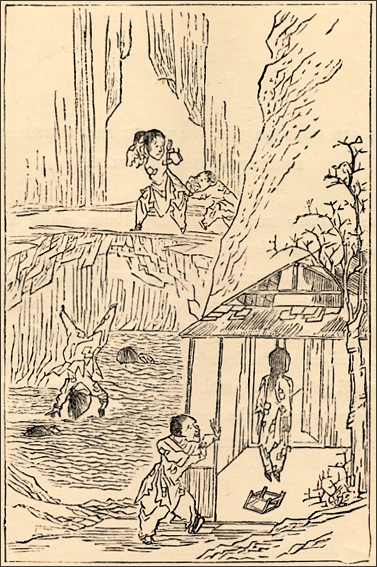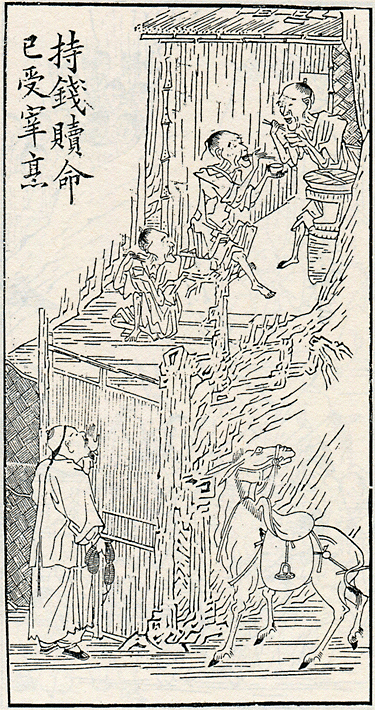| |
REACHING A NEW AUDIENCE
In addition to illustrations of women and children begin sold by
their starving families, other illustrations depict the agonies
experienced by women after they were sold to wealthy human traders,
who often transported them to brothels in Shanghai and elsewhere.
These images of tormented women were employed by Xie Jiafu and his
philanthropic colleagues to capture the attention and sympathy of new
and broader audiences. A print titled “Weeping Bitterly while Thinking of Home; Beaten on the Way” portrays an angry human trader raising a whip to beat a group of ragged girls who cower on the ground before him. The girls lift their arms in futile attempts to defend themselves from his blows.
The accompanying text is narrated in the voice of a literate woman from a good family who, unable to stop weeping, asks how she could have sunk to such a state. “The rattan whip strikes three blows; the pain penetrates my bones,” she cries. “Alas! May these abductors die ten thousand deaths!” [35] The human traders are the unmistakable villains in these pictures. Invariably depicted as well-fed, greedy, and cruel, such men are harshly condemned for their willingness to grow rich off the misery of their starving compatriots. The women, on the contrary, are portrayed as helpless and innocent victims in desperate need of protection. [36]
|
|
| |
|

|
 Beaten Along the Way—“Weeping bitterly while thinking of home, beaten on the way.” Beaten Along the Way—“Weeping bitterly while thinking of home, beaten on the way.”
“Si sheng gao zai tu qi,” 32a
[t010]
|

|
 Still other prints depict the plight of those driven to commit suicide during the famine. A woodblock print titled “Driven by Hunger and Cold, They Hang Themselves from a Beam or Throw Themselves in a River” portrays one figure standing on a chair preparing to hang herself, while three others prepare to jump in a river already populated by four silently floating corpses. [37] The illustration is strongly gendered: while the sex of three of the waterlogged corpses is unclear, all four living figures in the illustration, and at least one of the corpses, are female. Still other prints depict the plight of those driven to commit suicide during the famine. A woodblock print titled “Driven by Hunger and Cold, They Hang Themselves from a Beam or Throw Themselves in a River” portrays one figure standing on a chair preparing to hang herself, while three others prepare to jump in a river already populated by four silently floating corpses. [37] The illustration is strongly gendered: while the sex of three of the waterlogged corpses is unclear, all four living figures in the illustration, and at least one of the corpses, are female. |
 Suicide of Famine Victims—“Driven by hunger and cold, they hang themselves from a beam or throw themselves in a river.” Suicide of Famine Victims—“Driven by hunger and cold, they hang themselves from a beam or throw themselves in a river.”
“Si sheng gao zai tu qi,” 12a
[t008]
|
|
| |
|
 |
 “Suicide in Consequence “Suicide in Consequence
of the Famine”
[Legge plate V]
|
| |
The Taohuawu’s “pictures to draw tears from iron” were complex forms of cultural representation “in which the moral, the commercial, and the political” were closely intertwined. [38] While the images of suffering young women may to some extent have been used as “bait” for male voyeurs, the texts accompanying them consistently called on men to act as well as to gaze and to weep. A macabre illustration in one of the Taohuawu’s later compilations gave male readers a vivid example of the consequences of postponing active intervention. According to the text accompanying the illustration titled “[He] Brings Money to Redeem Life; [She Has] Already Been Slaughtered and Cooked,” a guest writing from one of the disaster-stricken provinces described how he had passed a butcher’s gate that was displaying different kinds of human meat. He saw that a young woman was about to be cooked, so he rushed home to get money to redeem her with.
|
|
 |

Unfortunately, by the time he arrived back at the gate the woman had already been killed. “Her rosy face could no longer be seen,” lamented her would-be-rescuer. “All that was left was her wronged ghost hanging in the air.” The message to the male reader was clear: horrible things were happening to defenseless young women in the famine districts. A generous donor could save them if he acted quickly, but there was no time to waste. [39] |
 Already Killed and Cooked— Already Killed and Cooked—
“[He] brings money to redeem
life; [she has] already been slaughtered and cooked.”
“Si sheng gao zai tu qi,” 26a
[t011] |
|
| |
The famine illustrations, like Xie Jiafu himself, also exemplify the hybrid character of Jiangnan responses to the famine. While the illustrations and accompanying laments borrowed from Qing poetry and traditional art forms such as New Year prints, they also served to inform new and broader audiences of the horrific situation in North China. [40] The front-page Shenbao editorial that introduced and endorsed the Henan qihuang tieleitu in the spring of 1878 highlighted the innovative character of the work. After outlining the subject matter of each of the 12 illustrations, the Shenbao editor compared the Henan qihuang tieleitu to a famous Song dynasty (960 to 1279) work, Liumintu (Pictures of Refugees), by Zheng Lanmin. The journalist argued that the new disaster booklet was even more admirable than the Song-period volume because it could rouse a wider audience to action. [41] The Song-era Liumintu, he wrote, was shared only with the emperor Shenzong, but the new tieleitu must “become known to all the masses.”
The Shenbao editor chose to print a front-page editorial recommending the illustrations specifically because of their ability to reach a new audience. “Why use them to encourage donations for each province afflicted with flood and drought?” he asked rhetorically at the end of his essay. “Because, though there have been many articles written to encourage relief, only the literate can understand them. But today when these illustrations go forth, even husbands, wives, and children in remote villages will all be able to understand them.” Since more people would grasp the extent of the disaster after viewing the illustrations, he concluded, more people would contribute to relief efforts. [42]
Xie Jiafu and other members of the Suzhou gentry may have begun printing famine illustrations with a traditional audience of wealthy scholars, officials, and merchants in mind. The content and style of the poetic laments in their illustration booklets were familiar and perhaps appealing to elite donors. In Shanghai, however, the Shenbao capitalized on what was new about the illustrations. It advertised Xie’s booklet as a creative method of drawing a broader, non-elite audience into the campaign to rescue Chinese famine victims in the northern provinces. Moreover, due to the foreign presence in Shanghai and possibly to contacts Xie Jiafu made with foreigners during his time in the city, less than a year after the volume appeared in Chinese an English edition of it was published in London, where it reached a wholly new foreign audience.
Translated by James Legge and issued by the Committee of the China Famine Relief Fund in 1878, excerpts from “Pictures to Draw Tears from Iron” also appeared in the China Inland Mission’s London-based journal, China’s Millions, where they almost certainly played a role in convincing British citizens to send donations to China. A hint of the English reaction to the volume can be detected in an article published in the Spectator shortly after the booklet’s appearance:
We have received from China a grotesque but pathetic little picture book, painting the horrors undergone in the famine districts … A great multiplication of this little book … would, we are persuaded, touch more minds and hearts than any mere circular. It brings home what famine means, at once vividly and with that pathos which is all the deeper for its quaint and grotesque character. [43]
The Western, English-language audience, particularly the editors of the British missionary journal China’s Millions, made use of the “Pictures to Draw Tears from Iron” in ways Xie Jiafu could not have imagined. In addition to calling on English Christians to send aid to Chinese famine victims, China’s Millions also encouraged them to fund more mission work that would help prevent future disasters by “shedding light upon the masses now in heathen darkness.” [44] Designed in Suzhou but advertised in treaty-port Shanghai and London, the famine illustrations took on new and in some cases quite unexpected meanings as they drew tears and monetary contributions from Jiangnan literati, treaty-port reformers, and English Christians.
|
|
| |

|
|
|





